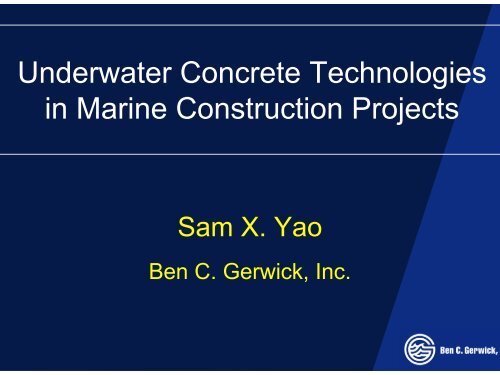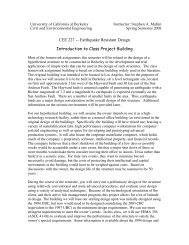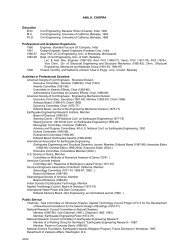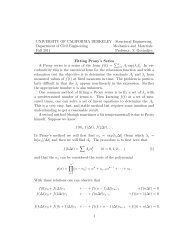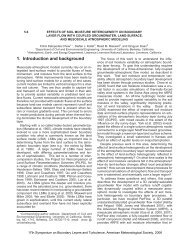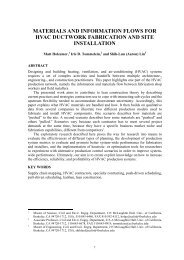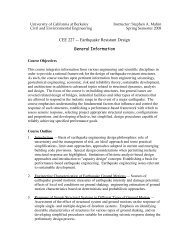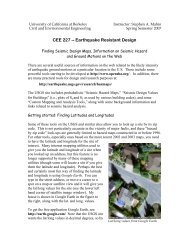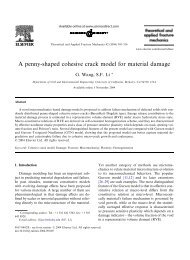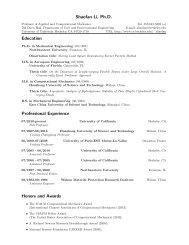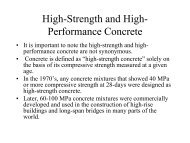Underwater Concrete Technologies in Marine Construction Projects
Underwater Concrete Technologies in Marine Construction Projects
Underwater Concrete Technologies in Marine Construction Projects
- No tags were found...
You also want an ePaper? Increase the reach of your titles
YUMPU automatically turns print PDFs into web optimized ePapers that Google loves.
oncrete Production from a Float<strong>in</strong>g Batch Plan
Conventional Tremie Placement
<strong>Concrete</strong> Delivery on Transit Mixers
Plac<strong>in</strong>g <strong>Concrete</strong> from a Delivery Barge
Tremie Placement with Suspended Pipes
<strong>Underwater</strong> <strong>Concrete</strong> <strong>Construction</strong> <strong>Technologies</strong><strong>Concrete</strong> Mix ProportionsWorkability and RheologyStrength Development<strong>Underwater</strong> <strong>Concrete</strong> <strong>Construction</strong><strong>Concrete</strong> Placement Plann<strong>in</strong>g<strong>Concrete</strong> Production/TransportatioMass Tremie <strong>Concrete</strong> PropertiesThermal BehaviorForm Pressure<strong>Concrete</strong> Placement ProceduresF<strong>in</strong>ish and ProtectionInspection and Quality ControlLaitance, Bleed<strong>in</strong>g, Segregation
erformance Requirements for Underwate<strong>Concrete</strong> <strong>in</strong> Structural Applications• Flowability and Self-Compaction• Workability Retention with<strong>in</strong> Work W<strong>in</strong>dow• Cohesion Aga<strong>in</strong>st Washout, Segregation, andLaitance Formation• Low Bleed<strong>in</strong>g• Low Heat of Hydration• Controlled Set Time• Compressive Strength• Adequate Bond
Washout Test and Slump Test
Slump vs. Slump Flow
Mock-up Tremie <strong>Concrete</strong> Test
Mock-up Tremie <strong>Concrete</strong> Test
Pr<strong>in</strong>cipal Parameters <strong>in</strong> Mix DesignParticle Pack<strong>in</strong>g Characteristics - SandContent, Gradation, Size, and ShapeThe water-to-f<strong>in</strong>e ratio - Enough F<strong>in</strong>e to Make ItFlowable and Cohesive (0.85-1.0 by volume)Cementittious Material Content – High VolumeFly Ash plus Silica FumeDispersion characteristics - Proper Use ofChemical Admixtures – HRWR and Set-retarder
Tremie <strong>Concrete</strong> Placement Plann<strong>in</strong>g – An Overviewllowable Work W<strong>in</strong>dowllowable Flow Distanceacement Area Configuration<strong>Concrete</strong> Production & Delivery:Method & Rate<strong>Concrete</strong> Placement SequenceTremie Placement Rate& ProcedureForm PressureISK FACTORSrodcution & Deliveryogisticsoss of Flowabilityashout - Laitanceegregation, Bleed<strong>in</strong>grapp<strong>in</strong>g of Waterxcessive DisturbancerosionTremie Pipe LayoutForm DesignSlope, Vent, Laitance CollectorQuality control plan:Test<strong>in</strong>g, sound<strong>in</strong>g, <strong>in</strong>spection<strong>Concrete</strong> Protection<strong>Concrete</strong> Flow PatternQuality of In-Situ <strong>Concrete</strong>StrengthUniformityBond
Initiation of Tremie PlacementInitiation of Placement us<strong>in</strong>gthe Dry Pipe Method with aEnd Plate as the Seal
c* h + Ww* D + FWcRHydrostatic Balance Po<strong>in</strong>tH = (W c h+W w D+F R ) / W c
Flow Patterns of Tremie CopncreteLayered Flow -Excessive LaitanceBulg<strong>in</strong>g Flow -M<strong>in</strong>imum Laitance
Tremie Pipe Spac<strong>in</strong>g3-5 Times Depthof Tremie Pours
Placement SequenceSimultaneous Placement MethodAdvanced Slope Method
Removal of Laitance <strong>Underwater</strong>
Lower Monumental Dam
Hydraulic Flow Pattern <strong>in</strong> Still<strong>in</strong>g Bas<strong>in</strong>
Pomona Dam Still<strong>in</strong>g Bas<strong>in</strong>Hydraulic Model Study
18 monthsafter repairK<strong>in</strong>zua Still<strong>in</strong>g Bas<strong>in</strong>
Erosion Damage
Erosion Damage Repair
Erosion Repair with<strong>in</strong> a Cofferdam
Undrewater Repair of a Dam
Tremie <strong>Concrete</strong> over Rock Anchor
Coarse Aggregatespecific Gravity: 2.85bsorption: 1.1%aximum Nom<strong>in</strong>alize: 3/4-<strong>in</strong>chppearance: Cleannd round-shapedith smooth surfacexture
F<strong>in</strong>e AggregatesSpecific Gravity: 2.72F<strong>in</strong>eness Modulus: 2.9”Absorption: 3.0%Natural River Sand
Gradations of AggregatesVolume Ratio ofF<strong>in</strong>e Aggregatesto TotalAggregates: 47%Volume Ratio ofCoarseAggregates toTotal Solids: 42%Percentage Pass<strong>in</strong>g100908070605040302010SandGrad<strong>in</strong>g CurveComb<strong>in</strong>edSand andGravelGravel0#200#100#50#30#16#8#43/8"1/2"3/4"1"1-1/2"Sieve Number
igh Volume Fly Ash <strong>Concrete</strong> for <strong>Underwater</strong> Repa• Reduct<strong>in</strong>g the heat ofhydration <strong>in</strong> massconcrete• Increas<strong>in</strong>g concreteflowability withoutcompromis<strong>in</strong>g cohesion• Facilitat<strong>in</strong>g concreteflowability retention andextended set time
Mix ProportionsMix No. 1 Mix No. 2 Mix No. 3(52% F.A) (25% F.A) (control)ement Type II, lb./cy 390 580 740ly Ash, lb./cy 350 160 0icro Silica, lb./cy 40 40 40oarse Agg, lb./cy 1.625 1,659 1,688<strong>in</strong>e Agg, lb./cy 1,367 1,396 1,420ater, lb./cy 301.8 302.5 303.3heomac UW, oz/cwt 85.8 85.8 85.8elvo, oz/cwt 117 117 117lenium, oz/cy 102.6 156 189
Compressive Strength Development12000.0Averag e Comp ressive Streng th (p si)10000.08000.06000.04000.02000.0Mix 3Mix 2Mix 10.00 10 20 30 40 50 60 70 80 90Age (days)
itial <strong>Concrete</strong> Slump10” to 10-3/4”itial Slump Flow21” to 26”<strong>in</strong>imum Requirementr Achiev<strong>in</strong>g 1:10lope on Top Surfacef the <strong>Concrete</strong> Pours10” Slump and 20”lump FlowWorkability Test
Workability Retention Testlump after 60 m<strong>in</strong>utes10” to 10-3/4”lump flow after 60 m<strong>in</strong>.21” to 26”nticipated work<strong>in</strong>dow for a truck ofoncrete45 m<strong>in</strong>utes
Set Time TestMix No. 1Set Time > 12 hourMix No. 2 and No. 3Set Time = 7 hourAnticipated <strong>Concrete</strong>Placement Duration:12 hours
emie <strong>Concrete</strong> Placement at the Dam Sit
Tremie <strong>Concrete</strong> Placement Sequence
Tremie <strong>Concrete</strong> Slump
Tremie <strong>Concrete</strong> Placement
<strong>Concrete</strong> Cores
Conventional Dam <strong>Construction</strong>
Cofferdam Failure
Conventional Lock <strong>Construction</strong>
Cofferdam Overtopp<strong>in</strong>g
Cleanup After the Flood
Braddock Dam
Braddock Dam - IllustrationTow<strong>in</strong>g andPosition<strong>in</strong>gIn Dam .ppt
BraddockGrout<strong>in</strong>g-In Dam .ppt
Braddock Dam – Stage 5<strong>Concrete</strong> Infill-In Dam .ppt
27.5 River Miles from Fabrication Site to Outfitt<strong>in</strong>g PierLeetsdale(Fabrication Site)3 MilesNOhio RiverEmsworth L/Dashields L/DMile 13.3PittsburghMile 14.7Mile 6.2Allegheny RiverBraddock L/DMile 0.0Duquesne RIDC(Outfitt<strong>in</strong>g Pier)Mile 11.2Monongahela RiverMile 12.8
In-the-Wet Foundation Preparation
<strong>Underwater</strong> FoundationsPILE DRIVINGBARGEFLOWSCREEDBARGEConcurrent Operations:• Dredge/Backfill• Place Base Stone• Screed Stone• Install Piers
Fabrication SiteLaunchBas<strong>in</strong>Segment 1Segment 2
Braddock Dam
Top Slab Fabrication
Segment 1 <strong>in</strong> Launch Bas<strong>in</strong>
Transport of Dam Segment 1
Tow<strong>in</strong>g and Sett<strong>in</strong>g a Float-<strong>in</strong> Dam
Braddock Dam
Sav<strong>in</strong>gs:1 Year5 MillionBraddock Dam
<strong>Construction</strong> Complete
Florida Keys
Coral Reef <strong>in</strong> Florida Keys
One of the Ground Sites
Damaged Coral Reef
Repair Design
Precast Repair Module
Repair of Corral Reef <strong>in</strong> Florida Keys
Sett<strong>in</strong>g a Precast Module
Float<strong>in</strong>g Batch Plants
Add<strong>in</strong>g Nitrogen Cool<strong>in</strong>g Agent
Repair of Coral Reef <strong>in</strong> Florida KeysPump<strong>in</strong>g <strong>Concrete</strong> <strong>Underwater</strong>
Plac<strong>in</strong>g <strong>Underwater</strong> <strong>Concrete</strong>
lac<strong>in</strong>g <strong>Concrete</strong> <strong>in</strong> Large Holes of Corral
F<strong>in</strong>ish<strong>in</strong>g <strong>Underwater</strong> <strong>Concrete</strong>
Project Location
Coachella Canal Eng<strong>in</strong>eer<strong>in</strong>g Data• <strong>Construction</strong> period 1938-1948• Length 123 mi• Diversion capacity 2,500 cfs• Typical section, earth l<strong>in</strong>ed:• Bottom width 40-60 ft• Side slopes 2:1• Water depth 10.3 ft• L<strong>in</strong><strong>in</strong>g, clay-blanket 12 <strong>in</strong>• Typical section, concrete l<strong>in</strong>ed:• Bottom width 12 ft• Side slopes 1.5 :1• Water depth 10.8 ft• L<strong>in</strong><strong>in</strong>g thickness 3.5 <strong>in</strong>
Salton Sea/Coachella CanalOne of numerous geothermal plantson the eastern side of the Salton Sea.Bombay Beach at Salton Sea.The Coachella Canal.Coachella Canal Bathers.
Installation of L<strong>in</strong>er and <strong>Concrete</strong> Overlay• Kiewit received a $5.2Million Contract toInstall 1.5 miles testsection at CoachellaCanal.• Pav<strong>in</strong>g half of a sectionat a time• Average Speed: 4-ft perm<strong>in</strong>ute
Canal L<strong>in</strong><strong>in</strong>g Design
• L<strong>in</strong>er: 30 mil thick PVCgeomembrane backedwith a nonwovengeotextile• Nonwoven fabricprevent slippage ofconcrete dur<strong>in</strong>gplacement andstrengthen the l<strong>in</strong>er• Vibrator on slip form toconsolidate andma<strong>in</strong>ta<strong>in</strong> concrete flowTrial Test<strong>in</strong>g
Completion of the L<strong>in</strong><strong>in</strong>g <strong>Construction</strong>


